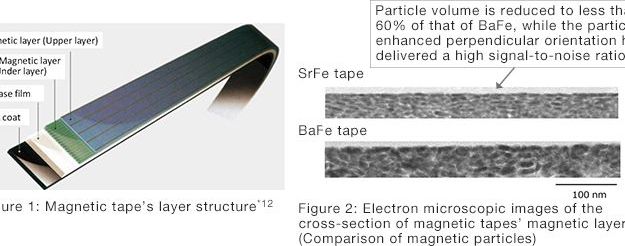The constant pressure of gravity affects our thoughts and perception, but it’s so constant we haven’t noticed – until now.



Sometimes, looking at things we thought we knew with fresh eyes (and new tools) can lead to incredible discoveries.
That’s what happened when Jeff Weinell, a graduate research assistant at the University of Kansas’ Biodiversity Institute, found out that three specimens of snakes preserved in the institute’s biodiversity collection, found in field missions between 2006 and 2012 and overlooked up to this point, belonged in a category of their own.
The three snake specimens are the only known members of a new snake genus, called Levitonius, and a new snake species, called Levitonius mirus.

“FUJIFILM Corporation (President: Kenji Sukeno) is pleased to announce that it has achieved the world’s record 317 Gbpsi recording density with magnetic tapes using a new magnetic particle called Strontium Ferrite (SrFe)*4. The record was achieved in tape running test, conducted jointly with IBM Research. This represents the development of epoch-making technology that can produce data cartridges with the capacity of 580TB (terabytes), approximately 50 times greater than the capacity of current cartridges*5. The capacity of 580TB is enough to store data equivalent to 120000 DVDs.”
TOKYO, December 162020 — FUJIFILM Corporation (President: Kenji Sukeno) is pleased to announce that it has achieved the world’s record 317 Gbpsi recording density with magnetic tapes using a new magnetic particle called Strontium Ferrite (SrFe) *4. The record was achieved in tape running test, conducted jointly with IBM Research. This represents the development of epoch-making technology that can produce data cartridges with the capacity of 580TB (terabytes), approximately 50 times greater than the capacity of current cartridges *5. The capacity of 580TB is enough to store data equivalent to 120000 DVDs.
SrFe is a magnetic material that has very high magnetic properties and is stable to maintain high performance even when processed into fine particles. It is widely used as a raw material for producing magnets for motors. Fujifilm has applied its proprietary technology to successfully develop ultra-fine SrFe magnetic particles, which can be used as a magnetic material for producing particulate magnetic tape media for data storage. The company has been conducting R&D for commercial use of SrFe magnetic particles as potential replacement of Barium Ferrite (BaFe) magnetic particles, currently used in magnetic tape data storage media. Magnetic tapes used in this test have been produced at the company’s existing coating facility, confirming the ability to support mass production and commercialization.
The amount of data in the society is exponentially increasing due to the introduction of high-definition 4K / 8K video, advancement in IoT / ICT, and the proliferation of Big Data analysis. “Cold Data,” or data that was generated a long time ago and rarely accessed, is said to account for over 80% of all data available today. There is a fast-growing trend of utilizing such Cold Data and other accumulated data, creating the need to secure safe, affordable and long-term data storage. Magnetic tapes have been used by major data centers and research organizations for many years as they not only offer benefits including large storage capacity, low cost and long-term storage performance, but also create air gap data protection, physically isolated from the network, thereby minimizing the risk of data damage or loss caused by cyberattacks.

COSPAR’s Planetary Protection Policy ensures scientific investigations related to the origin and distribution of life are not compromised.
Protecting the Earth from alien life sounds like the latest plot for a blockbuster thriller set in outer space. Whether it’s an invasion or a mysterious alien illness, the extraterrestrial threat to our planet has been well-explored in science fiction. But protecting the Earth from extraterrestrial contamination is not just a concept for our entertainment; as we explore further across our solar system and begin to land on our neighbouring planetary bodies, ensuring that we don’t bring potentially dangerous material home to Earth or indeed carry anything from Earth that may contaminate another planet is a responsibility we must take seriously.
So, who is responsible for ensuring that our space exploration is completed safely? Many nations around the world have their own space agencies, such as NASA and the European Space Agency, who run many different types of missions to explore space. States are responsible for their space activities under the Outer Space Treaty of 1967, including governmental and non-governmental actors. The Outer Space Treaty, among several provisions, regulates in its Article IX against harmful contamination. One of the core activities of the Committee on Space Research (COSPAR) is to develop, maintain, and promote a Policy on Planetary Protection, as the only international reference standard for spacefaring nations and in guiding compliance with Article IX of the Outer Space Treaty.
As we explore further across our solar system, ensuring we don’t bring potentially dangerous material home or indeed carry anything from Earth that may contaminate another planet and compromise scientific investigations is a responsibility we must take seriously.
COSPAR and its role COSPAR is part of the International Science Council, a non-governmental organisation that brings together many different scientific unions and research councils from all over the world. COSPAR was formed to promote international scientific research in space and provide a forum for the discussion of challenges to scientific exploration. COSPAR has a panel that regularly reviews the most up-to-date scientific research and advises COSPAR on new adaptations to planetary protection, for which policy updates and implementation guidelines are required.


Jason Asbahr.
Reese Jones
New research suggests that electrophysiological brain signals associated with neural plasticity could help explain the rapid, antidepressant effects of the drug ketamine. The findings, European Neuropsychopharmacology, indicate that ketamine could reverse insensitivity to prediction error in depression.
In other words, the drug may help to alleviate depression by making it easier for patients to update their model of reality.
“Ketamine is exciting because of its potential to both treat, and better understand depression. This is largely because ketamine doesn’t work the way ordinary antidepressants do – its primary mechanism isn’t to increase monoamines in the brain like serotonin, and so ketamine gives us new insight into other potential mechanisms underlying depression,” said lead researcher Rachael Sumner, a postdoctoral research fellow at The University of Auckland School of Pharmacy.

Humans have taken spiders into space more than once to study the importance of gravity to their web-building. What originally began as a somewhat unsuccessful PR experiment for high school students has yielded the surprising insight that light plays a larger role in arachnid orientation than previously thought.
The spider experiment by the US space agency NASA is a lesson in the frustrating failures and happy accidents that sometimes lead to unexpected research findings. The question was relatively simple: on Earth, spiders build asymmetrical webs with the center displaced towards the upper edge. When resting, spiders sit with their head downwards because they can move towards freshly caught prey faster in the direction of gravity.
But what do arachnids do in zero gravity? In 2008, NASA wanted to inspire middle schools in the US with this experiment. But even though the question was simple, the planning and execution of the experiment in space was extremely challenging. This led to a number of mishaps.

Here’s my latest video!
The Hallmarks of Aging are well established, but what is less discussed is the impact of microbes and/or microbial products. The bacterial metabolite, LPS, increases during aging, and it negatively impacts mitochondrial function, thereby demonstrating a role for microbial products on one of the Hallmarks of Aging, mitochondrial dysfunction.